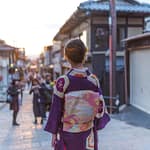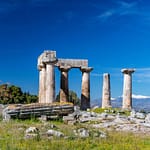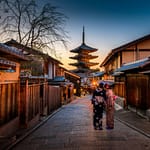TRAVEL AROUND
JAPAN
Japan, located in the heart of East Asia, is one of the most exciting and diverse countries to visit. It’s a destination that attracts travelers from all walks of life – whether you’re a budget backpacker, a couple on a romantic getaway, a solo adventurer, or seeking a luxury experience. Japan truly offers something for everyone.
From its rich ancient traditions to its cutting-edge technology, Japan is a country of contrast. You can wander through peaceful gardens, visit centuries-old temples, and immerse yourself in epic festivals. Alternatively, you might find yourself marveling at the towering skyscrapers, high-tech gadgets, and futuristic architecture. Japan’s natural beauty is equally diverse, offering everything from the serene beauty of cherry blossoms in spring to the snow-covered peaks in winter.
For first-time visitors, this guide is here to answer all your questions. We’ll explore the best times to visit Japan, the must-see destinations, travel costs, essential tips, and how to get ready for your unforgettable adventure. Whether you’re seeking history, nature, or modern experiences, you’ll find what you’re looking for in Japan.
Basic resources & travel tips
If you’re planning your first trip, check out our top travel tips to help you get started. We’ve also included some handy resources to make your visit easier and more enjoyable.
Top Destinations in Japan

Tokyo

Mount Fuji

Nara

Kamakura

Kyoto

Osaka

Hiroshima

Nikko
Smart Travel Tips & Costs for Visiting Japan
Japan is a destination that seamlessly blends the old with the new, offering everything from ancient temples to futuristic cities. Whether you’re planning your first visit or your tenth, understanding the costs and getting the best travel tips can make your trip smoother and more enjoyable. Here’s what you need to know to make the most of your journey to Japan.
Best Time to Visit Japan
- Spring (March-May): Ideal for cherry blossoms and mild weather—perfect for outdoor activities.
- Summer (June-August): Time for lively festivals and fireworks, but it can be hot and humid.
- Autumn (September-November): Beautiful fall colors and cool, pleasant weather—great for sightseeing.
- Winter (December-February): Best for skiing and relaxing in hot springs, though it’s cold, especially up north.
Spring and autumn are usually the best times to visit!
Travel Tips
Embrace the Culture of Respect
Japan is known for its polite and respectful culture, and as a traveler, you’ll need to show the same respect. Always bow when greeting someone, be mindful of your noise level, and avoid public displays of affection. Respect for personal space is important, so always line up for trains and buses, and keep your phone on silent in public places. It’s a little effort that goes a long way in making your trip smoother and more enjoyable.
Navigate Japan’s Transport with Ease
Japan’s public transportation system is legendary for its efficiency and precision. To get around like a local, consider investing in the JR Pass if you’re traveling between cities. It saves both time and money. For city transport, grab a Suica or Pasmo card to breeze through subway stations and buses without worrying about loose change. In cities like Tokyo and Osaka, the metro and bus systems are also easy to use. Be sure to download apps like Google Maps or HyperDia for navigating the train system with ease — trust us, it’s a lifesaver.
Cash is Still King, But Cards are Catching Up
While Japan has embraced technology, cash is still the most common form of payment in smaller towns. Always carry yen, especially for smaller purchases like vending machines or local restaurants. In major cities, credit cards and mobile payments are more widely accepted, but there’s no harm in having cash for peace of mind. ATMs are readily available and it’s a good idea to carry some yen, on many places also accept mobile payments like Suica or Apple Pay.
Language Barrier Tips
While most major attractions have English signage, Japan is still a country where speaking the local language can make a huge difference. Learn a few key phrases like “Konnichiwa” (Hello), “Sumimasen” (Excuse me) and “Arigatou” (Thank you). If you’re in a bind, Google Translate can be your best friend—download it before your trip for offline use.
Respect the Sacred Sites
When visiting Japan’s temples and shrines, it’s essential to follow proper etiquette. Always bow before entering, wash your hands and mouth at the purification fountain, and be quiet and respectful. Some places might prohibit photography, so always check before snapping a shot and make sure to ask first.
Travel Costs
Japan is known for being a relatively expensive destination, but there are plenty of ways to manage your budget without sacrificing experiences. Here’s a breakdown of the typical costs you might encounter
Accommodation
- Budget Travelers: Capsule hotels and hostels are a great option, ranging from ¥2,000 to ¥4,000 ($15–$30) per night. They’re compact, affordable, and efficient—perfect for travelers on the go.
- Mid-range Options: Traditional guesthouses and business hotels are your sweet spot, offering a balance of comfort and cost—about ¥8,000 to ¥15,000 ($60–$115) per night.
- Luxury Stays: Indulge in a high-end ryokan or hotel, where you can experience the finest Japanese hospitality. Prices for these upscale stays start from ¥20,000 ($150) and go up from there.
Food
Japan is a food lover’s paradise, and you don’t need to break the bank to experience the best it has to offer.
- Quick and Tasty: Convenience stores are your secret weapon—offering sushi, bento boxes, and even hot meals for as low as ¥500–¥1,500 ($4–$12).
- Sit-Down Restaurants: A mid-range meal will cost around ¥1,500–¥3,500 ($12–$25) per person, offering everything from ramen to tempura.
- Fine Dining: For a true culinary adventure, splurge on a meal at a top-notch restaurant like a sushi counter or kaiseki (traditional multi-course meal), where you can expect to spend ¥10,000+ ($75+).
Transportation
Japan’s transportation system is not only convenient and also easy to navigate but without proper planning long-distance travel can be costly:
- Metro or local bus: Fares start at around ¥200 ($1.50) per ride.
- JR trains (within cities): Expect to pay ¥500–¥1,500 ($4–$12) depending on the distance.
- Shinkansen (bullet train): For longer distances, prices can range from ¥10,000 to ¥20,000 ($75–$150) for a one-way trip between cities like Tokyo and Kyoto.
- Japan Rail Pass: A 7-day JR Pass for unlimited train travel costs around ¥29,000 ($225), offering excellent value for those traveling across the country.
Sightseeing and Activities
Japan offers plenty of free and budget-friendly attractions:
- Free & Fabulous: Public parks, temples, and gardens often charge nothing for entry. You can stroll through the serene Meiji Shrine in Tokyo or visit the iconic Fushimi Inari Shrine in Kyoto without spending a dime.
- Paid Attractions: Popular attractions like Tokyo Tower or Kyoto’s Kinkaku-ji (Golden Pavilion) will charge around ¥500–¥2,000 ($4–$15). Special experiences like tea ceremonies or sumo matches can cost anywhere from ¥3,000 to ¥10,000 ($25–$75).
Shopping: A World of Souvenirs & Gadgets
Japan offers a range of shopping experiences. If you’re into fashion or unique souvenirs to high-tech gadgets, you’ll find plenty of options:
- Souvenirs: Small trinkets, like keychains or snacks, can cost as little as ¥300–¥1,500 ($2–$12). Remember, some unique souvenirs like local crafts or ceramics will set you back a little more, but they’re worth it for the memories.
- Electronics: If you’re looking to purchase the latest gadgets, Japan has a range of electronics stores. Prices for things like cameras, headphones, and tech accessories tend to be slightly cheaper than in other countries, but always compare prices before you commit.
How to Travel Smart and Save Money in Japan
- Discount Passes & City Cards: Maximize your savings with city-specific travel passes that give you unlimited access to transport and sometimes even entry to attractions.
- Eat Like a Local: Convenience store meals might surprise you with their quality and value. It’s a quick, affordable, and delicious option for lunch or dinner.
- Stay in Capsule Hotels: For those willing to sacrifice space for comfort, capsule hotels are a great and economical way to stay in the heart of the city.
- Take Advantage of Free Attractions: Many of Japan’s most captivating spots, like gardens, shrines, and parks, are completely free to explore. Take advantage of these low-cost options to balance out pricier activities.
Final Word: Travel Smart, Travel Wise
Japan may seem like an expensive destination at first glance, but with a little planning and the right approach, you can explore this beautiful country on any budget. Whether you’re savoring sushi on the go, riding the bullet train, or visiting ancient temples, Japan promises a rich, diverse experience that’s worth every yen. Get ready to experience one of the world’s most fascinating countries—smartly, efficiently, and unforgettable.
Safety standards in Japan
Japan stands out globally for its impeccable safety standards across a range of sectors, from transportation to food, making it one of the safest countries to visit and live in. The nation’s commitment to public safety is evident in its meticulous regulations and attention to detail. Here’s a closer look at Japan’s safety pillars:
- Transportation: Japanese trains and buses are not just punctual—they are meticulously maintained and incredibly safe. The Shinkansen (bullet train) is a standout, running with stringent safety protocols. The country’s road systems are similarly well-regulated, with drivers adhering to strict traffic laws, ensuring smooth and secure travel.
- Infrastructure: Japan’s buildings are designed with earthquake resistance as a top priority, using cutting-edge engineering to safeguard against seismic events. Public spaces are equipped with clear evacuation routes and emergency systems, ensuring safety in case of an emergency.
- Food Safety: When it comes to food, Japan is uncompromising. Strict regulations ensure that food products are consistently high-quality and safe. Restaurants and food establishments follow rigorous hygiene protocols, delivering clean and fresh experiences every time.
- Crime Rate: One of Japan’s most remarkable traits is its incredibly low crime rate. Violent crime and theft are rare, making it one of the safest places in the world. The police force is highly professional, and the public’s adherence to laws contributes to a crime-free environment.
- Natural Disaster Preparedness: Though prone to earthquakes and tsunamis, Japan excels in disaster preparedness. The government has put in place robust early warning systems, regular evacuation drills, and a public education system that ensures both locals and visitors are ready in the event of a natural disaster.
Overall, Japan’s safety standards are unparalleled, ensuring a secure and peaceful environment for everyone. Whether it’s the efficient transportation system, the earthquake-resistant infrastructure, or the emphasis on food safety, Japan consistently delivers peace of mind to its people and visitors alike.



